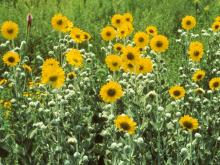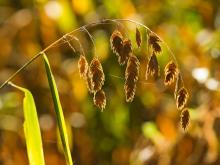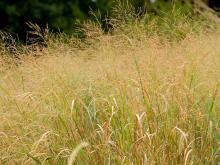Wildflowers, Grasses and Other Nonwoody Plants
Media

Species Types
Scientific Name
Asplenium rhizophyllum (syn. Camptosorus rhyzophyllus)
Description
One of Missouri’s most distinctive ferns, walking fern walks. Its long, triangular leaves take root at the elongated tips, forming new plantlets.
Media

Species Types
Scientific Name
Sagittaria spp.
Description
Arrowheads are aquatic plants with erect, usually arrow-shaped leaves and distinctive three-petaled flowers. They are often called duck potatoes because ducks, geese, and swans relish the tuberlike rootstocks.
Media

Species Types
Scientific Name
Helianthus spp.
Description
Most people recognize sunflowers when they see them, with their bright yellow ray flowers and rather flattened center of dark disk flowers. There are 16 species of Helianthus in Missouri.
Media

Species Types
Scientific Name
Symphyotrichum spp. (formerly Aster spp.)
Description
Missouri has 24 species of New World asters in genus Symphyotrichum. Most have purple or white ray flowers and yellow disk flowers that turn reddish over time. Most bloom in late summer and fall.
Media

Species Types
Scientific Name
Chasmanthium latifolium
Description
River oats is a native cool-season grass that is common nearly statewide in bottomlands, stream valleys, and other moist places. The open, nodding, flattened flower and seed clusters are distinctive.
Media

Species Types
Scientific Name
Panicum virgatum
Description
Switchgrass is a native perennial, warm-season, clump-forming mid or tall grass. In midsummer, delicate-looking, open, multiply-branching flowering clusters rise above the foliage.
Media

Species Types
Scientific Name
Eutrochium spp. (formerly Eupatorium spp.)
Description
Joe-Pye weeds have rounded clusters of pink or purplish flowers and leaves arranged in whorls on the stem. They are typically tall, robust plants growing in lowlands along streams. Missouri has three species.
Media

Species Types
Scientific Name
Eupatorium spp.
Description
Nine white-flowering species of thoroughworts, or bonesets, have been recorded for Missouri. They have rounded flower clusters that look rather fuzzy, because each little composite flowerhead lacks petal-like ray florets.
Media

Species Types
Scientific Name
Viola spp.
Description
Violets, as a group, are fairly easy to identify, with their colorful five-petaled “faces” so welcome in springtime. Missouri has 17 species, and some are confusingly similar. This page introduces them as a group.
Media

Species Types
Scientific Name
Viola missouriensis (syn. V. sororia var. missouriensis)
Description
Missouri violet is one of five Missouri stemless violets with purple or blue flowers and unlobed leaves. It is distinguished by its triangular or heart-shaped leaves that are longer than wide and are coarsely toothed only on the basal two-thirds.
See Also
About Wildflowers, Grasses and Other Nonwoody Plants in Missouri
A very simple way of thinking about the green world is to divide the vascular plants into two groups: woody and nonwoody (or herbaceous). But this is an artificial division; many plant families include some species that are woody and some that are not. The diversity of nonwoody vascular plants is staggering! Think of all the ferns, grasses, sedges, lilies, peas, sunflowers, nightshades, milkweeds, mustards, mints, and mallows — weeds and wildflowers — and many more!





















